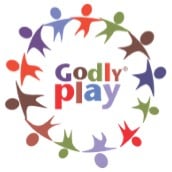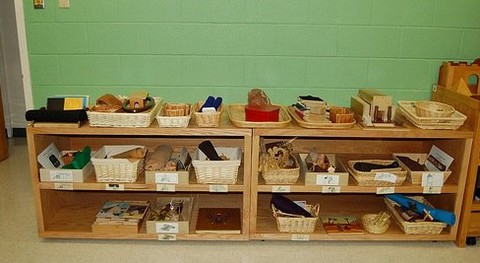 As I walked into the classroom, I noticed the simple white shelves that blended right into the walls. I was drawn like a magnet to the materials on these invisible shelves. The different hues of the natural woods, the heft of the brass, the richness of the velvet. Each material was placed on its own tray, organized and respected in their placement. As I walked the perimeter of the room, I realized that each of these were one of God’s glorious stories. Noah and ark, the birth of the Baby Jesus, and Sarah and Abraham. The room was set up with deliberate order. All of the old testament stories together, the new testament together, the parables together, and the lessons about worship.
As I walked into the classroom, I noticed the simple white shelves that blended right into the walls. I was drawn like a magnet to the materials on these invisible shelves. The different hues of the natural woods, the heft of the brass, the richness of the velvet. Each material was placed on its own tray, organized and respected in their placement. As I walked the perimeter of the room, I realized that each of these were one of God’s glorious stories. Noah and ark, the birth of the Baby Jesus, and Sarah and Abraham. The room was set up with deliberate order. All of the old testament stories together, the new testament together, the parables together, and the lessons about worship.
Then, It was time for the children to arrive. Two Godly Play guides were in place to lead the children through their worship for the day. The “greeter” stood at the door to welcome the children. She got down at their level and welcomed them by name in a quiet and peaceful voice. She invited them to meet the others at the circle for the story. Children who were not yet “ready” to become a part of the circle were allowed to stay with her. The storyteller began to share through actions words and teaching artifacts, the story of Sarah and Abraham. She placed a large sand-filled box in front of her and began, ” The desert is a dangerous place…” She did not make eye contact, allowing the children to get lost in the presentation of the lesson. All of the wiggles disappeared, there was not a sound in the room, and not one child interrupted. The child at the door, hesitant to enter, felt the pull of God’s Word to the circle and joined the other children. As the story ended, the wondering began, “guided” by the storyteller. “I wonder what part of the story you liked best?” “I wonder what part of the story is most important?”

As the wondering discussion faded, the children were then quietly invited to choose a work. One little girl said, “I want to work with The Creation.” Another child went to the art shelf to paint the story from the circle. They all quickly went to work. One young boy gave me the complete presentation of Noah! After work time, everyone joined together for their “feast” . During this time, the community comes together to share prayers, food, and each other. After the feast is distributed, the children prayed around the circle, some out loud and some quietly, some with their own words, some with prepared prayers. The children share juice and bread, muffins, etc. This is a foundation for communion. During this time, the story-teller asks about each child’s week. After, children came back to the circle for the “goodbye”, each child was called up by the storyteller who acknowledged a work or art expression the child had done that day.
They then said goodbye, and the child was dismissed. Children had placed the materials back on the shelves in the same organized manner in which they had taken them off the shelf. The art materials had been messy, but cleaned up by the children who used them. The whole group had cleaned up the feast. As the last child left, the classroom looked exactly as it had before 15 four-year-old children had arrived! Yes, four-year-old children.
http://www.youtube.com/watch?v=GRcKjaKp08w
Here are links to learn more about Godly Play and available resources. There is also a book from Amazon.com that outlines the approach.
In an age where we feel we need to meet children in their high-tech world, Godly Play is a unique way to present the beautiful and eloquent truths of the Bible in a very simple, natural form with no bells or whistles. “In most religious education, children are told who God is. In Godly Play, children discover who God is.” Using the principles of learning in the Montessori method, we respond to the child’s request to ‘help me do it by myself.’ It shares spiritual education in a beautiful, peaceful, intimate manner, demonstrating the power and richness of God through meaningful and intentional presentations of His Word. This puts the teacher in the role of spiritual supporter or guide who fully accepts that each child has his or her own relationship with God already.
Godly Play Bible stories are told gracefully and beautifully using simple hands on figures, made of natural and meticulously designed materials The storyteller, serves as a “guide” to the truth being told. Then, sits back and asks, “I wonder …?” allowing the children to find their own way. Children are encouraged to explore their thoughts, ideas and feelings about the story through expressive art following the presentation. One child, continually drew himself playing soccer. Frustrated by the irrelevance to the story and the repetition of is work, the teacher asked how the picture showed him God. He replied, Sometimes I am scared to play soccer out there by myself, but then I look at the great big sky and remember that God is with me.” She smiled and moved on.
The full Godly Play curriculum has several books and training videos that direct the roles of the teachers, lessons, the mood of the classroom, the dialogue, scripts, and presentations of the stories as well as the placement of the materials in the classroom. The room layout is intentional, and well thought out as are the presentations that are given to the children. Godly play materials are beautifully crafted from wood, bronze, and other natural materials that add “visual, tactile, and emotional dimensions to play.” These can be purchased or handmade. The training books are detailed but not in a step by step fashion. There is considerable work to be done on the part of the guides. I also found the reading to be deep, with much effort involved to explain philosophy, something I enjoyed, but volunteers may not have time for. Godly Play is definitely a philosophy of teaching not a quick curriculum. Everyone must understand it at its core and agree with its foundation for it to be successful. Also, the materials can be time-consuming to make and extremely expensive to buy, so I would not make the decision lightly to begin this program.
I wanted to “test” Godly Play resources on my toughest critics – 5th grade boys. They were captivated and awed by a story they had heard tens of times before, brought to silent reflection as the story unfolded. Maybe children don’t need the bells and whistles to make a connection to God’s truths. They need simplicity and relationship. This just might be the curriculum to help get that back.
